tow HYUNDAI I800 2016 Owners Manual
[x] Cancel search | Manufacturer: HYUNDAI, Model Year: 2016, Model line: I800, Model: HYUNDAI I800 2016Pages: 419, PDF Size: 9.23 MB
Page 11 of 419
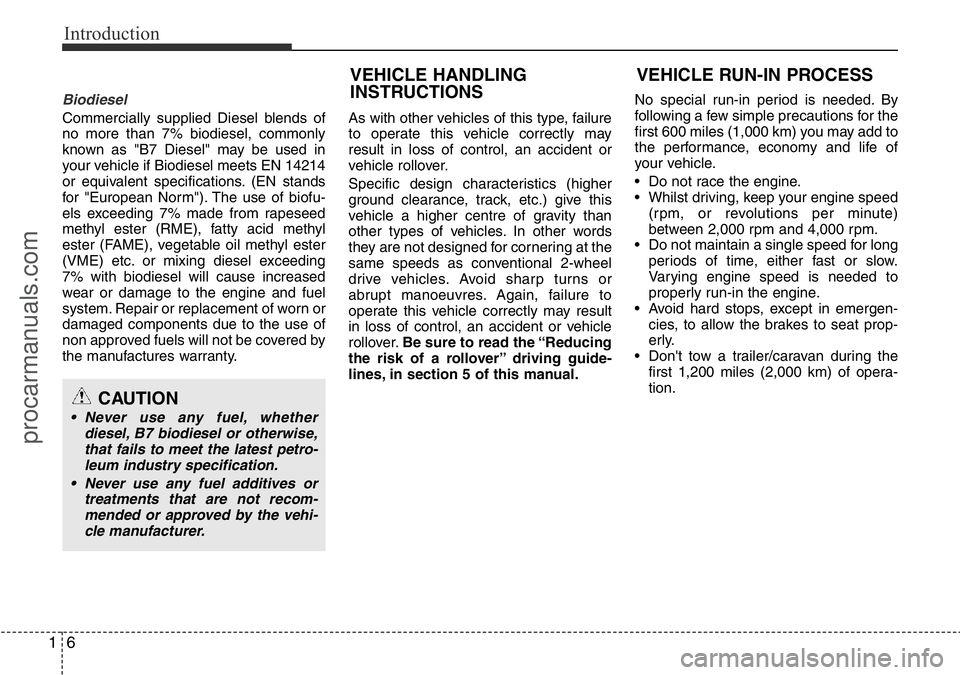
Introduction
6 1
Biodiesel
Commercially supplied Diesel blends of
no more than 7% biodiesel, commonly
known as "B7 Diesel" may be used in
your vehicle if Biodiesel meets EN 14214
or equivalent specifications. (EN stands
for "European Norm"). The use of biofu-
els exceeding 7% made from rapeseed
methyl ester (RME), fatty acid methyl
ester (FAME), vegetable oil methyl ester
(VME) etc. or mixing diesel exceeding
7% with biodiesel will cause increased
wear or damage to the engine and fuel
system. Repair or replacement of worn or
damaged components due to the use of
non approved fuels will not be covered by
the manufactures warranty.As with other vehicles of this type, failure
to operate this vehicle correctly may
result in loss of control, an accident or
vehicle rollover.
Specific design characteristics (higher
ground clearance, track, etc.) give this
vehicle a higher centre of gravity than
other types of vehicles. In other words
they are not designed for cornering at the
same speeds as conventional 2-wheel
drive vehicles. Avoid sharp turns or
abrupt manoeuvres. Again, failure to
operate this vehicle correctly may result
in loss of control, an accident or vehicle
rollover.Be sure to read the “Reducing
the risk of a rollover” driving guide-
lines, in section 5 of this manual.No special run-in period is needed. By
following a few simple precautions for the
first 600 miles (1,000 km) you may add to
the performance, economy and life of
your vehicle.
• Do not race the engine.
• Whilst driving, keep your engine speed
(rpm, or revolutions per minute)
between 2,000 rpm and 4,000 rpm.
• Do not maintain a single speed for long
periods of time, either fast or slow.
Varying engine speed is needed to
properly run-in the engine.
• Avoid hard stops, except in emergen-
cies, to allow the brakes to seat prop-
erly.
• Don't tow a trailer/caravan during the
first 1,200 miles (2,000 km) of opera-
tion.
VEHICLE RUN-IN PROCESS VEHICLE HANDLING
INSTRUCTIONS
CAUTION
• Never use any fuel, whether
diesel, B7 biodiesel or otherwise,
that fails to meet the latest petro-
leum industry specification.
• Never use any fuel additives or
treatments that are not recom-
mended or approved by the vehi-
cle manufacturer.
procarmanuals.com
Page 23 of 419
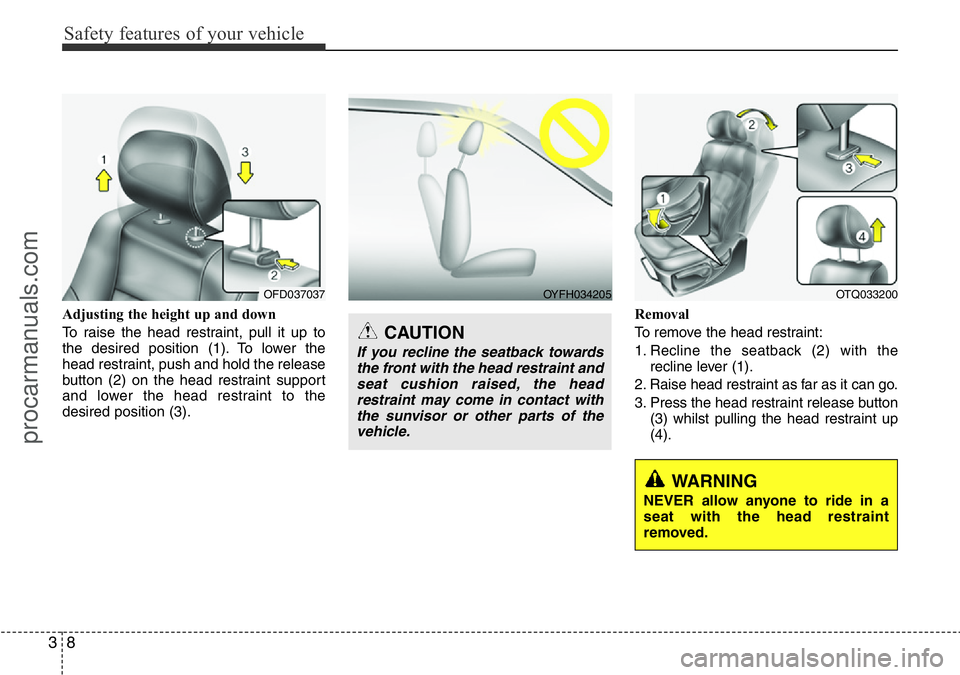
Safety features of your vehicle
8 3
Adjusting the height up and down
To raise the head restraint, pull it up to
the desired position (1). To lower the
head restraint, push and hold the release
button (2) on the head restraint support
and lower the head restraint to the
desired position (3).Removal
To remove the head restraint:
1. Recline the seatback (2) with the
recline lever (1).
2. Raise head restraint as far as it can go.
3. Press the head restraint release button
(3) whilst pulling the head restraint up
(4).
OFD037037OTQ033200
WARNING
NEVER allow anyone to ride in a
seat with the head restraint
removed.
OYFH034205
CAUTION
If you recline the seatback towards
the front with the head restraint and
seat cushion raised, the head
restraint may come in contact with
the sunvisor or other parts of the
vehicle.
procarmanuals.com
Page 27 of 419
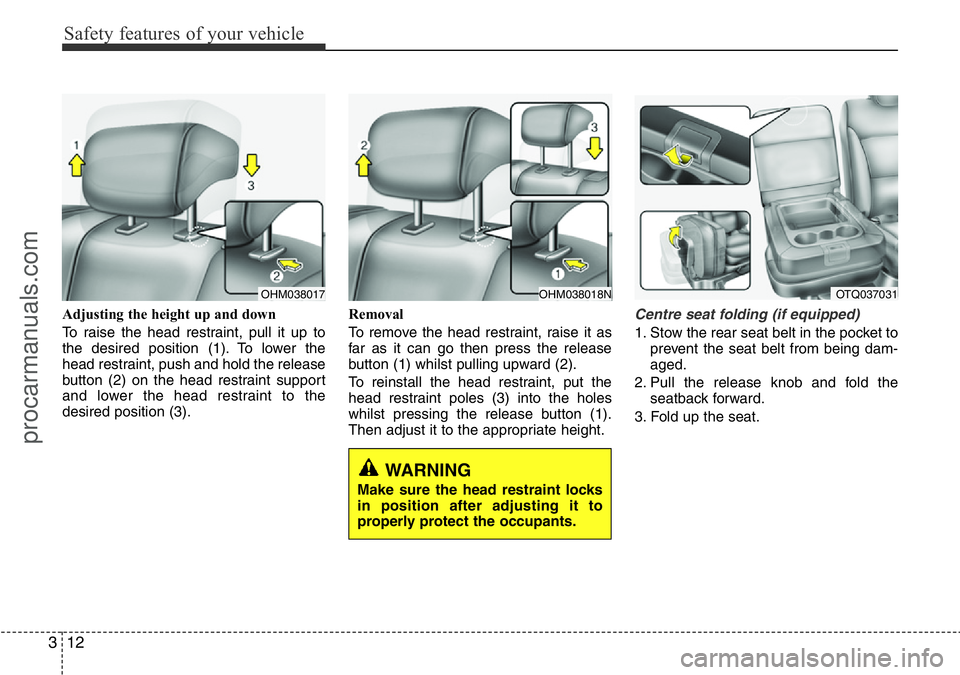
Safety features of your vehicle
12 3
Adjusting the height up and down
To raise the head restraint, pull it up to
the desired position (1). To lower the
head restraint, push and hold the release
button (2) on the head restraint support
and lower the head restraint to the
desired position (3).Removal
To remove the head restraint, raise it as
far as it can go then press the release
button (1) whilst pulling upward (2).
To reinstall the head restraint, put the
head restraint poles (3) into the holes
whilst pressing the release button (1).
Then adjust it to the appropriate height.Centre seat folding (if equipped)
1. Stow the rear seat belt in the pocket to
prevent the seat belt from being dam-
aged.
2. Pull the release knob and fold the
seatback forward.
3. Fold up the seat.
OHM038017OHM038018N
WARNING
Make sure the head restraint locks
in position after adjusting it to
properly protect the occupants.
OTQ037031
procarmanuals.com
Page 29 of 419
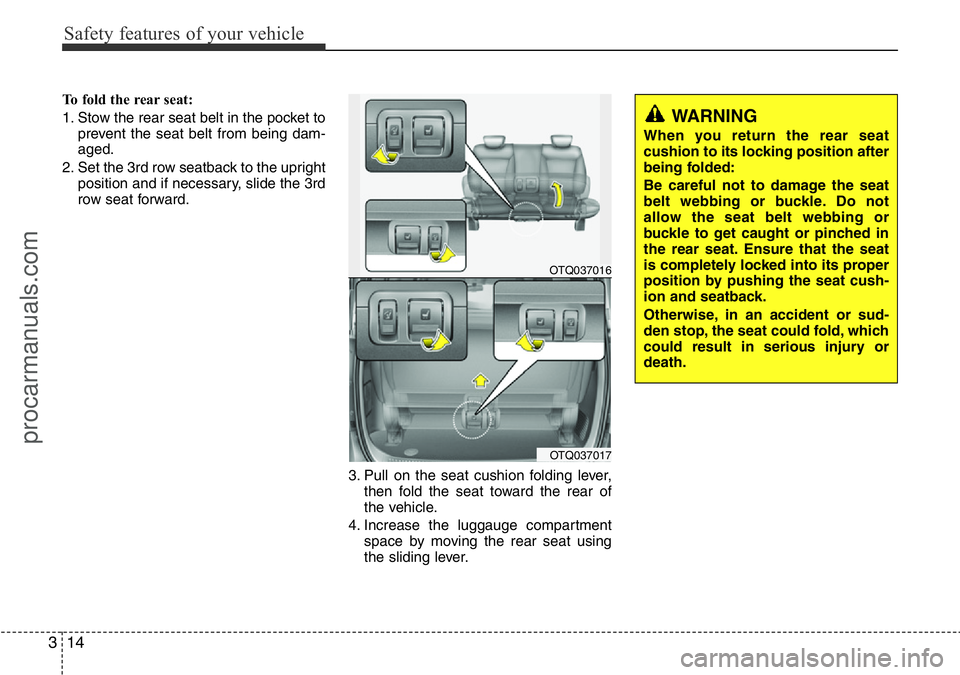
Safety features of your vehicle
14 3
To fold the rear seat:
1. Stow the rear seat belt in the pocket to
prevent the seat belt from being dam-
aged.
2. Set the 3rd row seatback to the upright
position and if necessary, slide the 3rd
row seat forward.
3. Pull on the seat cushion folding lever,
then fold the seat toward the rear of
the vehicle.
4. Increase the luggauge compartment
space by moving the rear seat using
the sliding lever.
OTQ037016
OTQ037017
WARNING
When you return the rear seat
cushion to its locking position after
being folded:
Be careful not to damage the seat
belt webbing or buckle. Do not
allow the seat belt webbing or
buckle to get caught or pinched in
the rear seat. Ensure that the seat
is completely locked into its proper
position by pushing the seat cush-
ion and seatback.
Otherwise, in an accident or sud-
den stop, the seat could fold, which
could result in serious injury or
death.
procarmanuals.com
Page 36 of 419
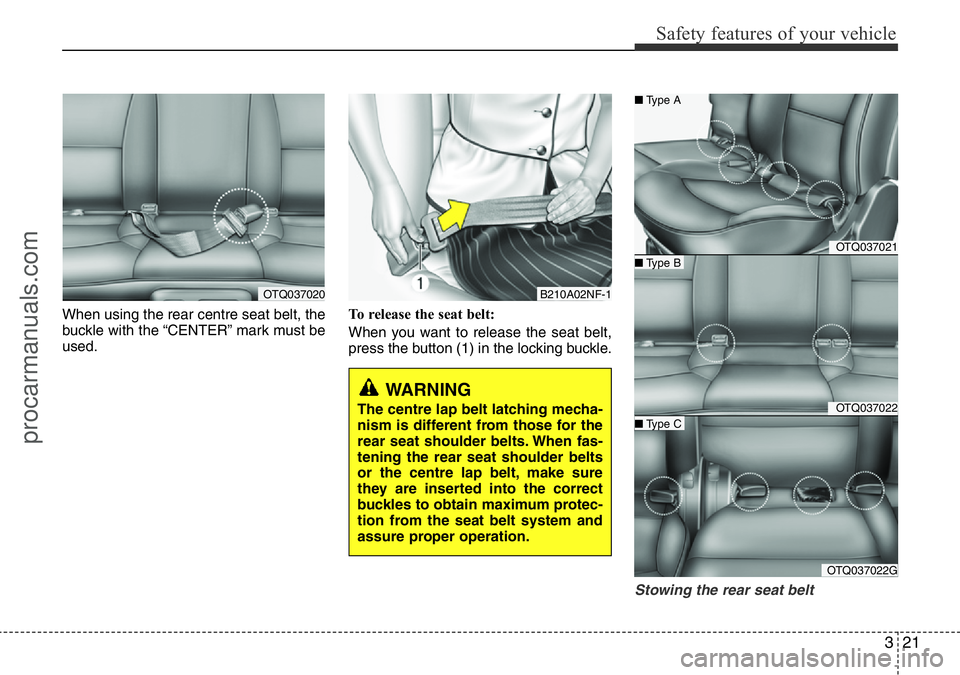
321
Safety features of your vehicle
When using the rear centre seat belt, the
buckle with the “CENTER” mark must be
used.To release the seat belt:
When you want to release the seat belt,
press the button (1) in the locking buckle.
Stowing the rear seat belt
OTQ037020B210A02NF-1
WARNING
The centre lap belt latching mecha-
nism is different from those for the
rear seat shoulder belts. When fas-
tening the rear seat shoulder belts
or the centre lap belt, make sure
they are inserted into the correct
buckles to obtain maximum protec-
tion from the seat belt system and
assure proper operation.
OTQ037021
OTQ037022
OTQ037022G
■Type B ■Type A
■Type C
procarmanuals.com
Page 37 of 419
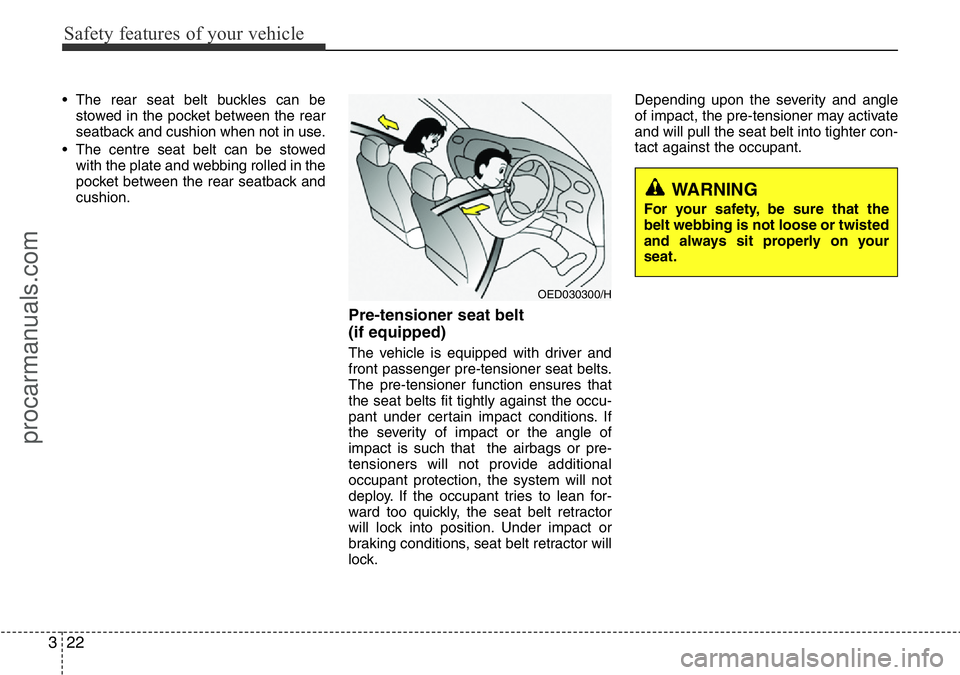
Safety features of your vehicle
22 3
• The rear seat belt buckles can be
stowed in the pocket between the rear
seatback and cushion when not in use.
• The centre seat belt can be stowed
with the plate and webbing rolled in the
pocket between the rear seatback and
cushion.
Pre-tensioner seat belt
(if equipped)
The vehicle is equipped with driver and
front passenger pre-tensioner seat belts.
The pre-tensioner function ensures that
the seat belts fit tightly against the occu-
pant under certain impact conditions. If
the severity of impact or the angle of
impact is such that the airbags or pre-
tensioners will not provide additional
occupant protection, the system will not
deploy. If the occupant tries to lean for-
ward too quickly, the seat belt retractor
will lock into position. Under impact or
braking conditions, seat belt retractor will
lock.Depending upon the severity and angle
of impact, the pre-tensioner may activate
and will pull the seat belt into tighter con-
tact against the occupant.
OED030300/H
WARNING
For your safety, be sure that the
belt webbing is not loose or twisted
and always sit properly on your
seat.
procarmanuals.com
Page 48 of 419
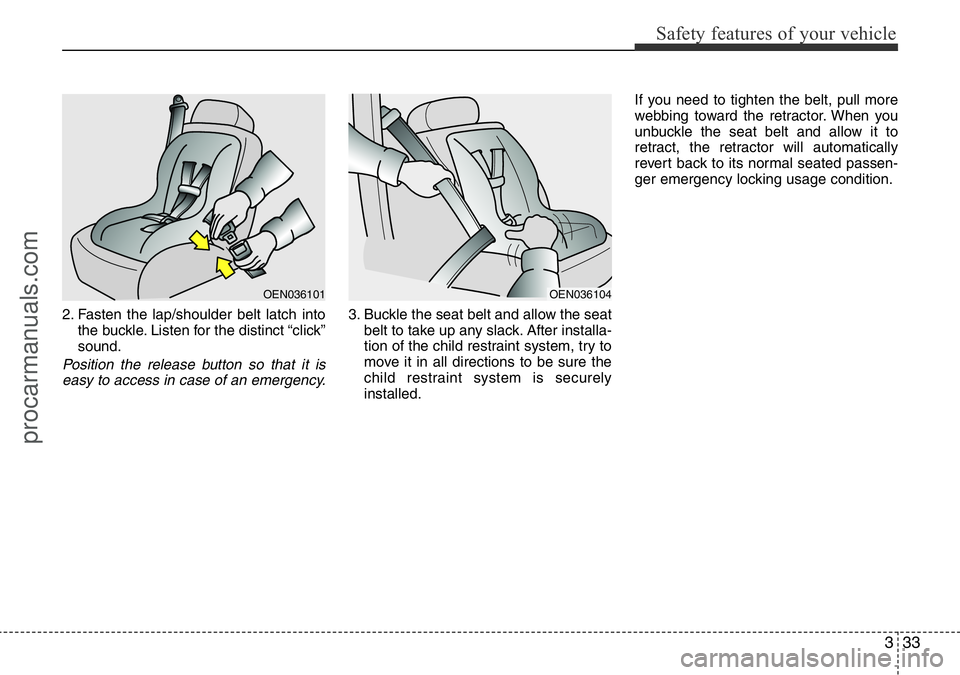
333
Safety features of your vehicle
2. Fasten the lap/shoulder belt latch into
the buckle. Listen for the distinct “click”
sound.
Position the release button so that it is
easy to access in case of an emergency.
3. Buckle the seat belt and allow the seat
belt to take up any slack. After installa-
tion of the child restraint system, try to
move it in all directions to be sure the
child restraint system is securely
installed.If you need to tighten the belt, pull more
webbing toward the retractor. When you
unbuckle the seat belt and allow it to
retract, the retractor will automatically
revert back to its normal seated passen-
ger emergency locking usage condition.
OEN036101OEN036104
procarmanuals.com
Page 83 of 419
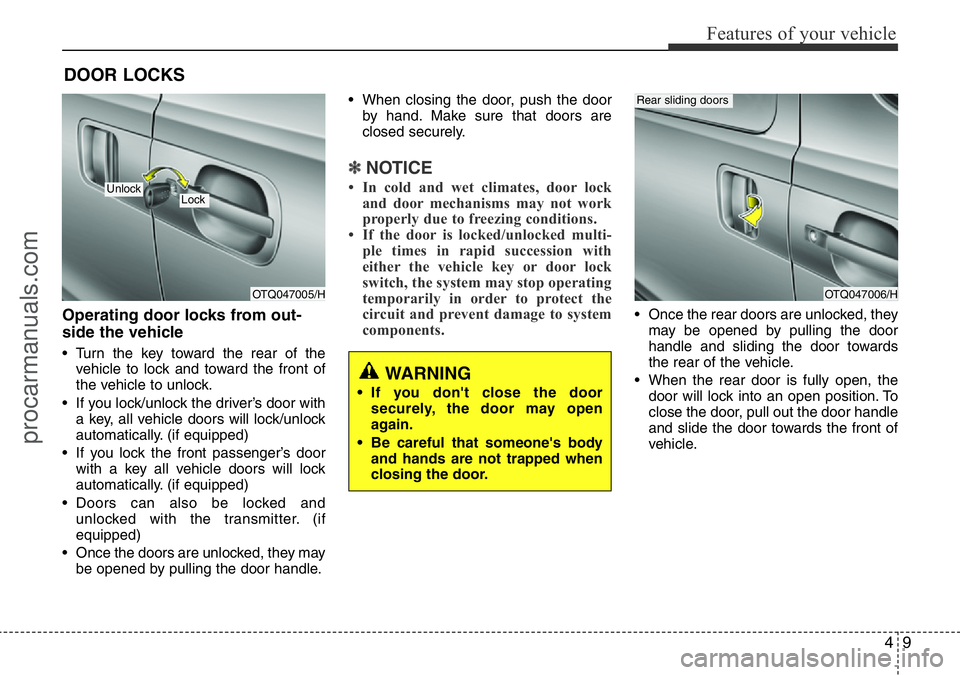
49
Features of your vehicle
Operating door locks from out-
side the vehicle
• Turn the key toward the rear of the
vehicle to lock and toward the front of
the vehicle to unlock.
• If you lock/unlock the driver’s door with
a key, all vehicle doors will lock/unlock
automatically. (if equipped)
• If you lock the front passenger’s door
with a key all vehicle doors will lock
automatically. (if equipped)
• Doors can also be locked and
unlocked with the transmitter. (if
equipped)
• Once the doors are unlocked, they may
be opened by pulling the door handle.• When closing the door, push the door
by hand. Make sure that doors are
closed securely.
✽NOTICE
• In cold and wet climates, door lock
and door mechanisms may not work
properly due to freezing conditions.
• If the door is locked/unlocked multi-
ple times in rapid succession with
either the vehicle key or door lock
switch, the system may stop operating
temporarily in order to protect the
circuit and prevent damage to system
components.
• Once the rear doors are unlocked, they
may be opened by pulling the door
handle and sliding the door towards
the rear of the vehicle.
• When the rear door is fully open, the
door will lock into an open position. To
close the door, pull out the door handle
and slide the door towards the front of
vehicle.
DOOR LOCKS
OTQ047005/H
UnlockLock
OTQ047006/H
Rear sliding doors
WARNING
• If you don't close the door
securely, the door may open
again.
• Be careful that someone's body
and hands are not trapped when
closing the door.
procarmanuals.com
Page 109 of 419
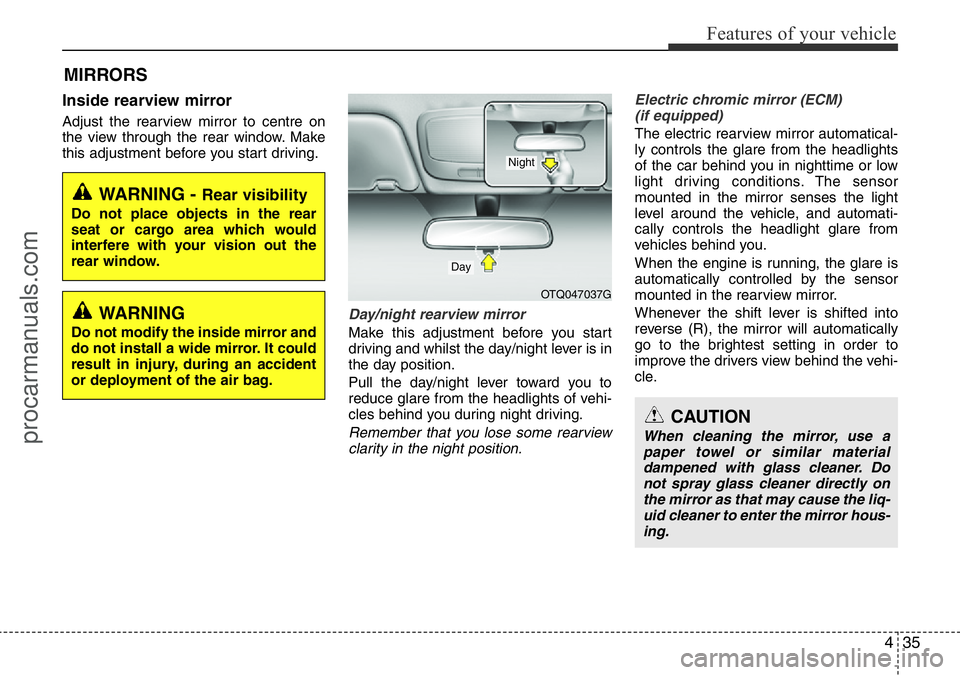
435
Features of your vehicle
Inside rearview mirror
Adjust the rearview mirror to centre on
the view through the rear window. Make
this adjustment before you start driving.
Day/night rearview mirror
Make this adjustment before you start
driving and whilst the day/night lever is in
the day position.
Pull the day/night lever toward you to
reduce glare from the headlights of vehi-
cles behind you during night driving.
Remember that you lose some rearview
clarity in the night position.Electric chromic mirror (ECM)
(if equipped)
The electric rearview mirror automatical-
ly controls the glare from the headlights
of the car behind you in nighttime or low
light driving conditions. The sensor
mounted in the mirror senses the light
level around the vehicle, and automati-
cally controls the headlight glare from
vehicles behind you.
When the engine is running, the glare is
automatically controlled by the sensor
mounted in the rearview mirror.
Whenever the shift lever is shifted into
reverse (R), the mirror will automatically
go to the brightest setting in order to
improve the drivers view behind the vehi-
cle.
MIRRORS
WARNING - Rear visibility
Do not place objects in the rear
seat or cargo area which would
interfere with your vision out the
rear window.
OTQ047037G
CAUTION
When cleaning the mirror, use a
paper towel or similar material
dampened with glass cleaner. Do
not spray glass cleaner directly on
the mirror as that may cause the liq-
uid cleaner to enter the mirror hous-
ing.
Day
Night
WARNING
Do not modify the inside mirror and
do not install a wide mirror. It could
result in injury, during an accident
or deployment of the air bag.
procarmanuals.com
Page 112 of 419
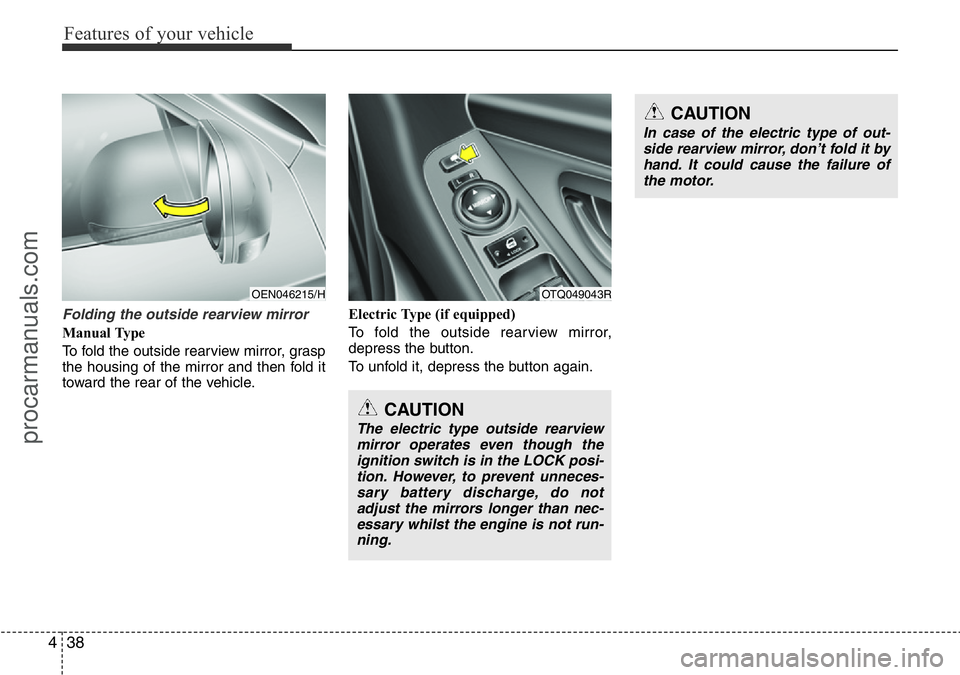
Features of your vehicle
38 4
Folding the outside rearview mirror
Manual Type
To fold the outside rearview mirror, grasp
the housing of the mirror and then fold it
toward the rear of the vehicle.Electric Type (if equipped)
To fold the outside rearview mirror,
depress the button.
To unfold it, depress the button again.
OEN046215/HOTQ049043R
CAUTION
In case of the electric type of out-
side rearview mirror, don’t fold it by
hand. It could cause the failure of
the motor.
CAUTION
The electric type outside rearview
mirror operates even though the
ignition switch is in the LOCK posi-
tion. However, to prevent unneces-
sary battery discharge, do not
adjust the mirrors longer than nec-
essary whilst the engine is not run-
ning.
procarmanuals.com